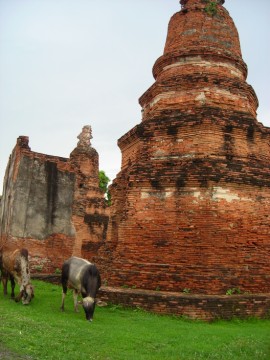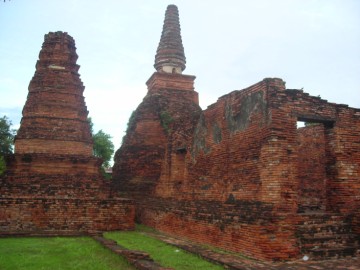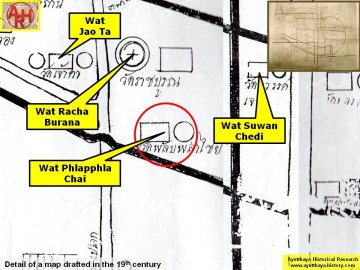| WAT PHLABPHLA CHAI (วัดพลับพลาไชย) |
| This restored ruin is located on the corner of Chikun Road and Pa Maphrao Road. It is roughly situated between Wat Racha Burana and Wat Suwannawat. The area is referred to as the Pratu Chai district. There are three primary structures remaining at Wat Phlabphla Chai. At its entrance was a sermon hall. Three walls have survived, and some fragments of Buddha images can be seen on its altar. The sermon hall’s basic foundation has been reconstructed by the Fine Arts Department. Behind the sermon hall is a large bell-shaped chedi. Its spire and harmika have been rebuilt, but a large hole has been dug into the relic chamber by looters. A third chedi is located beside this one. The third chedi was constructed in the style of the Late Ayutthaya period. It is pyramidal and has multiple layers with indented corners. This rises in a prang-like structure, but its upper portion is gone. There is evidence that it once has niches at the relic chamber. In addition, the boundary walls of this restored ruin are clear at the ground level. There is also a small sub-structure south of the sermon hall that has small room-like cells made from brick and mortar. This could have been used as monk quarters. Another sub-structure exists on the northern side of the monastery, but the only thing remaining is a reconstructed floor. This monastery was built in an east/west axis facing Khlong Pratu Khao Pluak (now buried underground). It would have been situated within the old city walls. Foreign maps show the area directly west of it as a location for elephant stables (Vingboons 1665, Coronelli 1696, de La Loubere 1691). There is not much known about this monastery’s history or date of establishment. A hand-painted sign in situ suggests it was used as a military base in 1424 by Prince Ai Phraya before fighting a duel with his brother on elephant back. According to Royal Chronicles, after King Intharacha died in 1424, two sons fought for the throne in an area at the foot of Than Forest Bridge. Prince Ai Phraya set himself up at the Municipality of Maphrao (coconut) Forest at the Chai Pavilion, while his brother Prince Yi Phraya set himself up at the Chaiyaphum Monastery so as to enter the city by way of Chao Phrom Market (Cushman 15). Both brothers had their throats torn open at the same time by war scythes and neither of them survived. A third brother inherited the throne instead. It is believed by some scholars that Wat Phlabphla Chai is the Chai Pavillion mentioned in the Royal Chronicles, and coconut groves can still be seen near the monastery even today. This information suggests that the monastery was established in the Early Ayutthaya period. However, none of its structures resemble the architectural style of the Early Ayutthaya Period. The closest Khmer-style prangs from this period are found at Wat Chaiyaphum and at Wat Langka. Based on architecture style, it is reasonable to argue that Prince Ai Phraya might have actually set up in the vicinity of Wat Langka instead. |

| Text & photographs by Ken May - September 2009 Maps by Tricky Vandenberg - March 2015 |



| (View of Wat Phlabphla Chai) |
| (View of Wat Phlabphla Chai) |
| (One of the chedi at Wat Phlapphla Chai) |



| (Detail of a 19th century map - Courtesy of the Sam Chao Phraya Museum - map is orientated S-N) |
| (Detail of Phraya Boran Rachathanin's map - Anno 1926) |
| (Detail of a 2007 Fine Arts Department GIS map - Courtesy of the Fine Arts Department - 3th Region) |


| (Source: Phra Rachawang lae Wat Boran nai Jangwat Phra Nakhon Sri Ayuthaya - 2511. Courtesy of the Fine Arts Department - 3th Region) |